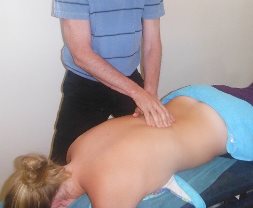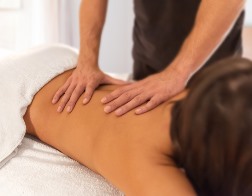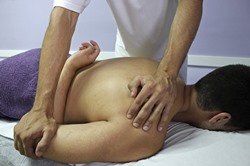What is Therapeutic Massage?
 As mentioned in the introduction, massage therapy is an alternative form of healing that provides relief from pain and helps people function better. The massage therapist manually stimulates muscles, tissue and skin to diminish stress and eliminate tension and pain in their clients. Swedish, or Classic Massage, is the kind of massage that many people think of when discussing therapeutic massage, and the majority of Kihei HI massage therapy schools teach it as their principal type of massage. But keep in mind, there are numerous other types of massage that schools may or may not include as part of their course of instruction. Below are some of the more popular examples.
As mentioned in the introduction, massage therapy is an alternative form of healing that provides relief from pain and helps people function better. The massage therapist manually stimulates muscles, tissue and skin to diminish stress and eliminate tension and pain in their clients. Swedish, or Classic Massage, is the kind of massage that many people think of when discussing therapeutic massage, and the majority of Kihei HI massage therapy schools teach it as their principal type of massage. But keep in mind, there are numerous other types of massage that schools may or may not include as part of their course of instruction. Below are some of the more popular examples.
- Neuromuscular Therapy Massage
- Deep Tissue Massage
- Sports Massage
- Shiatsu Massage
- Thai Massage
- Hot Stone Massage
- Pregnancy Massage
Practitioners that work in massage therapy are properly referred to as massage therapists. From time to time you might hear them called a masseuse or a masseur, which refers to a female or a male massage practitioner. Unfortunately, these names often have a negative connotation among the general public and Kihei HI professionals alike and are better avoided.
Massage Therapist Training Requirements
 Almost all Kihei HI massage therapy programs require enrolling students have a high school diploma or its equivalent to qualify. Programs can vary in length from several months for a Certificate or a Diploma to as long as 2 years to earn an Associate’s Degree. How long the programs are will also vary by State based on the training hours required for licensing. Another factor that may also influence the program length is whether classes are scheduled during the day or at night. Also, an Associate Degree in Massage Therapy often has general education requirements and the credits may be transferrable into a similar Bachelor’s Degree Program. Once you have received your Degree, Diploma or Certificate, the education doesn’t stop there. The amount and type of continuing education you will need to complete will depend on the State where you are licensed. Some states require both a certain number of hours of continuing education as well as specific education in subjects, such as HIPPA compliance or ethics.
Almost all Kihei HI massage therapy programs require enrolling students have a high school diploma or its equivalent to qualify. Programs can vary in length from several months for a Certificate or a Diploma to as long as 2 years to earn an Associate’s Degree. How long the programs are will also vary by State based on the training hours required for licensing. Another factor that may also influence the program length is whether classes are scheduled during the day or at night. Also, an Associate Degree in Massage Therapy often has general education requirements and the credits may be transferrable into a similar Bachelor’s Degree Program. Once you have received your Degree, Diploma or Certificate, the education doesn’t stop there. The amount and type of continuing education you will need to complete will depend on the State where you are licensed. Some states require both a certain number of hours of continuing education as well as specific education in subjects, such as HIPPA compliance or ethics.
Massage Therapist Licensing
 Once you have graduated from an accredited Kihei HI massage therapy program, the next step is to obtain your license in the State where you will be practicing. The Massage & Bodywork Licensing Examination (MBLEx), is an exam controlled and administered by the Federation of State Massage Therapy Boards (FSMTB) and is mandated by the majority of States as part of the licensing process. Some States have their own or additional exams, so check with your State before enrolling in a massage therapy program. If you do not pass the MBLEx in the first attempt, you can re-take it after thirty days but must pay an additional exam fee. After obtaining your license, you will need to maintain it in most states, which means complying with renewal requirements and paying a renewal fee. As previously mentioned, renewal typically requires a certain number of hours of continuing education be completed. And if you should move to another State, licensing will be required for that new State also. Each State has different regulations for massage therapists, so do not assume that you will automatically be qualified for licensing. Check with your new State before moving to confirm that you have satisfied the requirements to practice legally there.
Once you have graduated from an accredited Kihei HI massage therapy program, the next step is to obtain your license in the State where you will be practicing. The Massage & Bodywork Licensing Examination (MBLEx), is an exam controlled and administered by the Federation of State Massage Therapy Boards (FSMTB) and is mandated by the majority of States as part of the licensing process. Some States have their own or additional exams, so check with your State before enrolling in a massage therapy program. If you do not pass the MBLEx in the first attempt, you can re-take it after thirty days but must pay an additional exam fee. After obtaining your license, you will need to maintain it in most states, which means complying with renewal requirements and paying a renewal fee. As previously mentioned, renewal typically requires a certain number of hours of continuing education be completed. And if you should move to another State, licensing will be required for that new State also. Each State has different regulations for massage therapists, so do not assume that you will automatically be qualified for licensing. Check with your new State before moving to confirm that you have satisfied the requirements to practice legally there.
